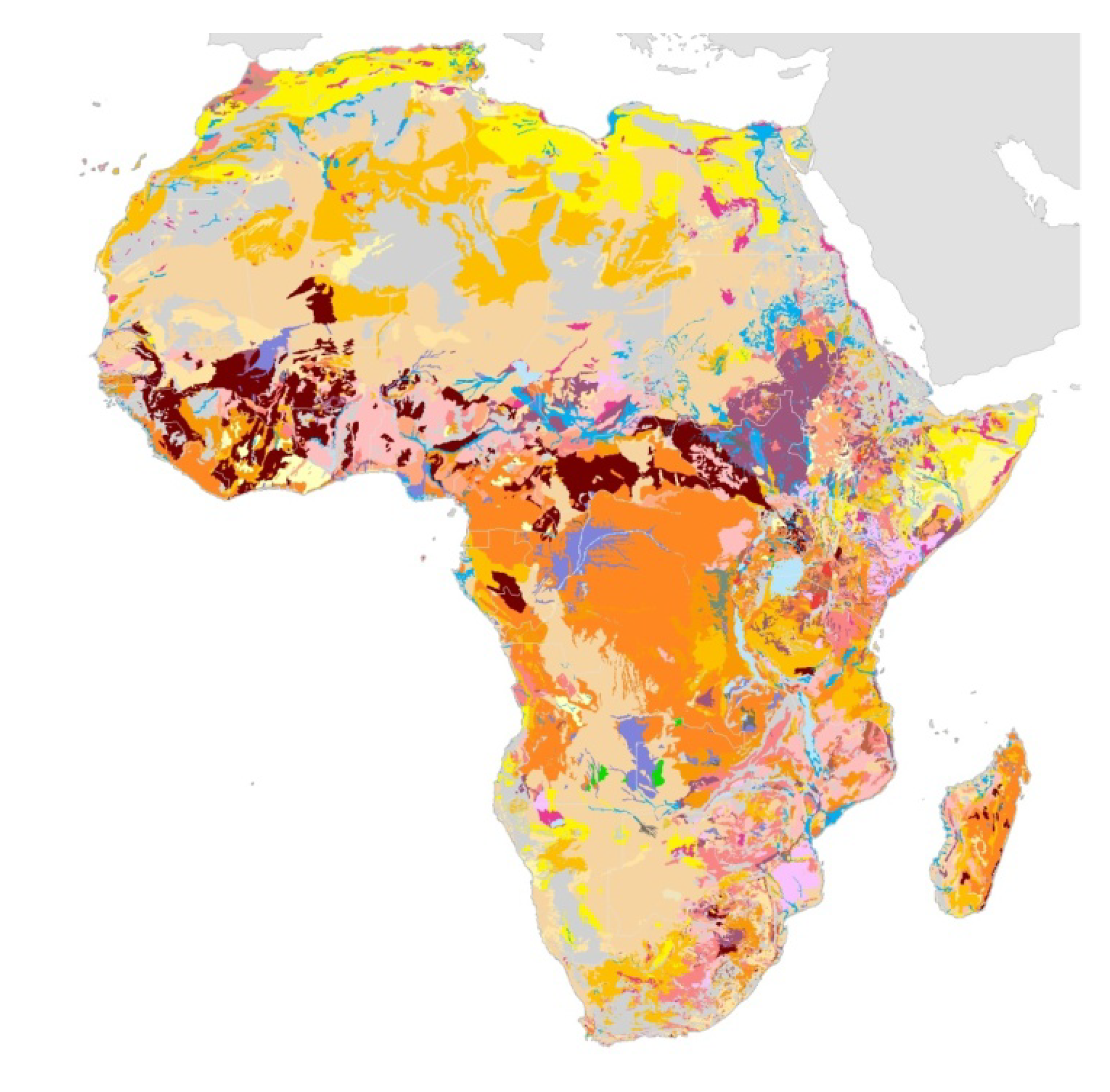How Soil Scientists Help Combat Podoconiosis, A Neglected Tropical Disease

Acknowledgments
Conflicts of Interest
References
- Korevaar, D.A.; Visser, B.J. Podoconiosis, a neglected tropical disease. Neth. J. Med. 2012, 70, 210–214. [Google Scholar]
- Visser, B.J.; Korevaar, D.A.; van der Zee, J. A 24-year-old Ethiopian farmer with burning feet. Am. J. Trop. Med. Hyg. 87. [CrossRef]
- Footwork, the International Podoconiosis Initiative. Available online: http://www.podo.org (accessed on 12 May 2014).
- Wanji, S.; Tendongfor, N.; Esum, M.; Che, J.N.; Mand, S.; Tanga Mbi, C.; Enyong, P.; Hoerauf, A. Elephantiasis of non-filarial origin (podoconiosis) in the highlands of north-western Cameroon. Ann. Trop. Med. Parasitol. 2008, 102, 529–540. [Google Scholar] [CrossRef]
- Ruberanziza, E.; Mupfasoni, D.; Karibushi, B.; Rujeni, N.; Kabanda, G.; Kabera, M.; Kaberuka, T.; Nizeyimana, V.; Kramer, M.H.; Mukabayire, O.; et al. Mapping of lymphatic filariasis in Rwanda. J. Lymphoedema 2009, 4, 20–23. [Google Scholar]
- Deribe, K.; Brooker, S.J.; Pullan, R.L.; Hailu, A.; Enquselassie, F.; Reithinger, R.; Newport, M.; Davey, G. Spatial distribution of podoconiosis in relation to environmental factors in Ethiopia: A historical review. PLoS One 2013, 8. [Google Scholar] [CrossRef]
- Soil Maps. European Commission—Joint Research Centre, Institute for Environment and Sustainability. Available online: http://eusoils.jrc.ec.europa.eu/library/maps/maps.html (accessed on 12 May 2014).
- Jones, A.; Breuning-Madsen, H.; Brossard, M.; Dampha, A.; Deckers, J.; Dewitte, O.; Gallali, T.; Hallett, S.; Jones, R.; Kilasara, M.; et al. Soil Atlas of Africa; Publications Office of the European Union: Luxembourg, EU, 2013; p. 176. Available online: ://eusoils.jrc.ec.europa.eu/library/ maps/africa_atlas/ (accessed on 12 May 2014).
- Deribe, K.; Meribo, K.; Gebre, T.; Hailu, A.; Ali, A.; Aseffa, A.; Davey, G. The burden of neglected tropical diseases in Ethiopia, and opportunities for integrated control and elimination. Parasit Vectors 2012, 5. [Google Scholar] [CrossRef]
- International Medical Geology Association. Available online: http://www.medicalgeology.org/pages/public/medicalgeology/page_MedGeo.htm (accessed on 12 May 2014).
- Joint Research Centre. European Soil Portal—Soil Data and Information Systems, Soil Atlas of Africa. Available online: http://eusoils.jrc.ec.europa.eu/library/maps/africa_atlas/ (accessed on 12 May 2014).
- Brooker, S.J.; Smith, J.L. Mapping neglected tropical diseases: A global view. Community Eye Health. 2013, 26. Available online: http://www.ncbi.nlm.nih.gov/pmc/articles/PMC3756648/ (accessed on 12 May 2014).
- Bhunia, G.S.; Kesari, S.; Jeyaram, A.; Kumar, V.; Das, P. Influence of topography on the endemicity of Kala-azar: A study based on remote sensing and geographical information. Geospat. Health 2010, 4, 155–165. [Google Scholar]
- Chammartin, F.; Scholte, R.G.; Malone, J.B.; Bavia, M.E.; Nieto, P.; Utzinger, J.; Vounatsou, P. Modelling the geographical distribution of soil-transmitted helminth infections in Bolivia. Parasit Vectors 2013, 6. [Google Scholar] [CrossRef] [Green Version]
- Global Atlas of Helminth Infections (GAHI). Available online: http://www.thiswormyworld.org/maps (accessed on 12 May 2014).
© 2014 by the authors; licensee MDPI, Basel, Switzerland. This article is an open access article distributed under the terms and conditions of the Creative Commons Attribution license (http://creativecommons.org/licenses/by/3.0/).
Share and Cite
Visser, B.J. How Soil Scientists Help Combat Podoconiosis, A Neglected Tropical Disease. Int. J. Environ. Res. Public Health 2014, 11, 5133-5136. https://doi.org/10.3390/ijerph110505133
Visser BJ. How Soil Scientists Help Combat Podoconiosis, A Neglected Tropical Disease. International Journal of Environmental Research and Public Health. 2014; 11(5):5133-5136. https://doi.org/10.3390/ijerph110505133
Chicago/Turabian StyleVisser, Benjamin Jelle. 2014. "How Soil Scientists Help Combat Podoconiosis, A Neglected Tropical Disease" International Journal of Environmental Research and Public Health 11, no. 5: 5133-5136. https://doi.org/10.3390/ijerph110505133



